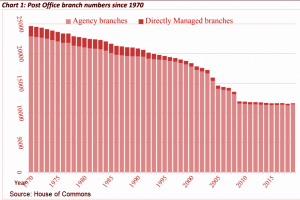If there was a silver lining to the Horizon computer scandal, a 16-year saga that landed over 700 subpostmasters in the dock and more in debt as a result of buggy accounting software, it was that it brought to light the important role the unsung subpostmaster plays in the country’s communications network.
The subpostmasters embroiled in the Fujitsu balls-up were franchisees. As are the vast majority of today’s post office operators. Indeed, the UK’s postal service is the largest retail franchise network in Europe.
Franchise holders license the business from the Post Office, which, when it isn’t falsely accusing them of pilfering, supports them, usually in the form of funding and training; it otherwise takes a back seat and lets them get on with running the day-to-day business.
Franchising has long been a fixture of the UK’s postal system – the majority of offices had already been franchised by the 1970s and the remainder continue to pass into private hands (see chart).

2010 Changes shifting to Retail
Another trend has been a downward one. In the year 2000, the UK could boast a postal network of almost 20,000 offices.
That number steadily dwindled throughout the noughties – a state of affairs the government sought to address with its Network Transformation Programme, a far-reaching reform agenda it hoped would arrest the decline in visitor numbers and bring the postal service into the 21st century.
Chief among the changes was doing away with the traditional ‘fortress’ approach to organising the local post office, where staff sat immured behind reinforced glass.
In its stead, a more open-plan, retail-oriented approach was to be employed. The thinking was that this would allow post office staff to come out from behind the ‘bandit barrier’ screen and work in a hybrid role – part postmaster, part retailer.
Current State of Play

The shift to a more retail-focused approach has paid dividends. According to HIM! research, 78% of people who visit their local post office also tend to buy something from the retail side of the business.
The same research found that 73% of shoppers say that the services on offer in the post office are the main reason for their being in the store in the first place.
The success of the new model has driven the conversion to them – around 7,500 out of a total of 11,684 now operate as one of these post office-cum-convenience stores.
That figure of 11,684 is a substantial reduction on turn-of-millennium post office numbers, but it is still one that gives the service some headroom when it comes to meeting the government’s target of maintaining a network of at least 11,500 branch locations.
In addition to maintaining office numbers, the Post Office is also charged with meeting national and local access criteria – its offices must be sited equably across the British Isles so locals have access to key postal services wherever they are in the country.
The numbers suggest the service is meeting its targets. Today, 99.7% of Britons live within three miles of a post office and 93% must travel less than a mile to find one. Perhaps surprisingly, the majority (54%) of today’s post offices can be found in rural locations.
In addition to meeting accessibility criteria, the service must also provide customers with what the government considers ‘services of general economic interest’.
These include:
- Payment of social security benefits.
- Tax credit payments.
- National identity and licensing scheme processing.
- Facilities for paying public utility bills.
- Access to basic cash and banking facilities.
Three Types of Post Office

The 2010 changes didn’t just change the floor plan and focus of the UK’s post offices; they also brought about a shift to a tripartite organisational structure.
The three types of post office are:
- Post Office Locals. These offer a limited range of post office services and because they are often located in a local retail store, tend to stay open longer than the other two. The serving counter is often shared by both the post office and the on-site retail business.
- Main Post Offices. In these larger post offices, the full range of post office services are on offer – from mail and parcels to banking and benefit payments. They are typically housed on the premises of a large retail chain such as WHSmith or the Co-Op.
- Crown Post Offices. Today, just 1% (around 117 branches) of post offices qualify as Crown post offices, which are directly managed and run by Post Office Limited. They are increasingly being offered to franchise operators.
Post Office Franchisee Qualities
A subpostmaster doesn’t receive a fixed salary; instead, he receives a small cut of all the goods and services he sells in his branch.
As such, prospective franchisees must possess good retail awareness and a keen marketing sense to make a go of running a franchise.
The Post Office’s website suggests potential franchisees should be “self-motivated, sales-focused and innovative”.
Adding a Post Office to a Retail Business

If the prospective franchisee feels he meets these criteria, there are a few ways he can go about acquiring one, including purchasing an existing one and setting up a new branch where previously there wasn’t one.
However, the most common route to becoming a franchisee is to add a post office to a retail outlet.
In this case, the prospective franchisee needs to arrange an on-site meeting with the Post Office to discuss his plan for the business.
Should the prospective franchisee pass this first hurdle, the next step is to complete a business plan, the Electronic Business Plan (EBP), which is done online via a link the Post Office sends to potential franchisees.
The Post Office website suggests applicants take some time at this point to prepare the documents needed for the application because the plan – plus scanned copies of supporting documents – must be submitted within 28 days of starting the application.
Required Documents
The main pieces of documentation the franchisee must provide include:
- If the retail company to which the post office will be added has traded for at least three years, then three years’ worth of company accounts must be submitted. The accounts are assessed at the interview stage. If the business has traded for less than three years, two guarantors are required.
- Three months of bank statements for all parties to the application.
- Evidence of any funding the franchisee plans to put into the post office.
If the business plan is approved, an interview will be arranged so Post Office bosses can drill down into the franchisee’s plans.
At this stage, the Post Office will expect the applicant to demonstrate an understanding of not just the local postal business but the larger network of which it is part.
Applicants typically receive a decision on the application within a couple of weeks of the final interview.
Should the application be successful, further meetings will be arranged to allow the Post Office to install signage, an EPOS system and marketing material.
More information about current Post Office franchise opportunities can be found here.
Support & Training for Subpostmasters
For those lucky enough to be awarded a franchise, the Post Office provides training and support to get the franchisee on his feet. This typically involves familiarising the new franchisee with the company’s equipment, forms, and procedures.
The training period lasts for six months and is extended to all staff at the post office, not just the postmaster.
Once the initial six-month period is up, support is then provided online, by phone or during one of the regular visits from a Post Office area manager.
The Post Office also puts on refresher courses to show subpostmasters how to master sales techniques and introduce cost-cutting measures. And branch-specific surgeries can also be requested if the subpostmaster feels his branch needs extra help.
Recent Post Office Developments

The Post Office’s staple business, mailing letters through its sister company, Royal Mail, has taken a battering in recent years.
Its most recent annual report laid out the scale of the problems that beset the service in 2023. The network’s bread-and-butter mail business was disrupted by 18 days of strikes and a cyber-attack on Royal Mail. Mail delivery was 13% down year-on-year as a result.
The Post Office has been trying to limit its exposure to the labour disputes that convulse Royal Mail with great regularity.
To this end, it loosened its relationship with the company in March 2021, bringing rival parcel carriers into the fold. Customers can now use Amazon, DPD, DHL Express and most recently Evri to send parcels in addition to Royal Mail and its allied carrier, Parcel Force.
In November 2022, the Post Office strengthened its relationship with Evri further when the company became only the second carrier (after Royal Mail) to provide a complete end-to-end service from some branches in the service’s 370-year history.
Banking, Benefits and Pensions
As well as diversifying its parcel-carrying business, the Post Office is also transforming itself into something of a local banking hub in some communities, especially those underserved or unserved by the big banks.
Post Office has partnerships with over 30 banks, building societies and credit unions, meaning that 99% of UK bank customers can access their accounts via their local post office.
In February 2024, figures showed that local post offices handled £3.37bn of cash deposits and withdrawals in January 2024, a year-on-year increase of £140m (£3.23bn).
The Post Office also operates its banking service, the Post Office Card Account, which disburses pension payments and benefits to its 1.1 million plus members, many of whom don’t have access to a regular bank account.
New Horizons
The Post Office has set itself three goals going forward: increase branch profitability, replace the discredited Horizon accounting system, and rebuild trust among subpostmasters.
Horizon’s replacement, currently in development, will be “built with postmasters, for postmasters” and promises to be “faster, simpler, and more intuitive to use,” says the Post Office. And we hope more trustworthy.
The Post Office is also lending more of an ear to subpostmasters’ concerns and in 2021, for the first time in its history, invited two serving postmasters, Saf Ismail and Elliot Jacobs, to sit on its board as non-executive directors.
At the local level, the Post Office has also beefed up its area manager network, with issues brought to local managers’ attention subsequently aired at a newly established monthly Voice of the Postmaster meeting.
Author Profile
- Freelance Journalist & Content Creator
- Content creator and contributor, freelance journalist and writer.
Latest entries
 EventsJune 19, 2025The 14 Best Food Festivals in London for 2025
EventsJune 19, 2025The 14 Best Food Festivals in London for 2025 EventsJune 10, 2025How To Beat The Famous ‘Wimbledon Queue’ For Wimbledon Tickets 2025
EventsJune 10, 2025How To Beat The Famous ‘Wimbledon Queue’ For Wimbledon Tickets 2025 London DirectoriesMay 27, 2025Top 10 Thames Cruises For Entertaining Sightseeing in London
London DirectoriesMay 27, 2025Top 10 Thames Cruises For Entertaining Sightseeing in London HospitalityMay 15, 2025London’s 8 Best Japanese Afternoon Tea Experiences: Matcha, Sencha and More
HospitalityMay 15, 2025London’s 8 Best Japanese Afternoon Tea Experiences: Matcha, Sencha and More


